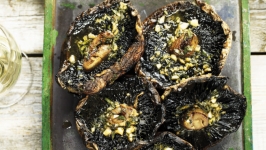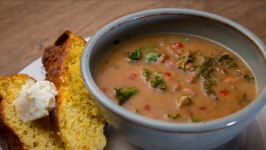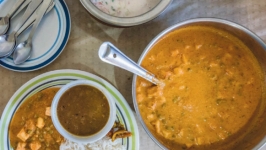Ingredients
- 1 pasture-raised fresh chicken (approximately 4 pounds), or if frozen, thawed
- salt
- 2 tablespoons olive oil, or melted butter
- 2 tablespoons chopped fresh sage, or 1 tablespoon dried
- 2 tablespoons lemon juice
- 1 tablespoon crushed garlic
- 1 teaspoon ground black pepper
- 1 cup dry white wine or chicken broth
- 6 to 12 whole garlic cloves
Instructions
Brine or salt the chicken:
To brine the chicken (preferred method): Place the chicken in a stockpot and add 1/2 cup salt. Add water to cover the chicken and put a lid on the pot. Chill in refrigerator up to 36 hours.
To salt the chicken: Dry the chicken with paper towels. Use your fingers to loosen the skin from the meat. Measure out 1/2 teaspoon salt per pound of chicken (a 4-pound chicken will need 2 teaspoons salt). Rub the salt all over the chicken, including under the loosened skin. You can also use a long spoon to reach under the skin to distribute the salt. Set the chicken breast-side up in a roasting pan and chill, uncovered, up to 36 hours.
When ready to roast, preheat the oven to 400°. If you brined and did not already do this, use your fingers to loosen the skin from the meat.
Combine olive oil or melted butter, sage, lemon juice, crushed garlic, and black pepper. Rub the mixture all over the chicken, including under the loosened skin.
Place chicken on one of its sides in a roasting pan. Pour wine or broth into the bottom of the pan and add the whole garlic cloves to pan. Initially roast 25 minutes for a smaller bird or 30 minutes for a larger one.
Turn the chicken on its other side and roast 25 to 30 minutes more.
Turn the chicken breast side up and roast 15 to 30 minutes more, until a thermometer inserted into the thickest part of the thigh reads 165°. Internal temperature is the best indicator and helps to keep the chicken from being overcooked, but if you don’t have a thermometer, you can tell that the chicken is done when the leg moves freely in the thigh joint and the juices run clear when the thickest part of the thigh is pierced.
When done roasting, let the chicken rest out of the oven for 10 minutes before carving.
Variations:
• Herbs and spices: try separately or in combination: thyme, oregano, fennel leaves or seeds, basil, cilantro, lemongrass, ginger, coriander, cumin, onion flakes, orange juice or zest.
• Spicy: add 1/4 teaspoon cayenne to the herb mixture.
• Smokey: add 1 teaspoon smoked paprika to the herb mixture.
• Pesto: rub with 1/4 - 1/2 cup of high-quality pesto.








